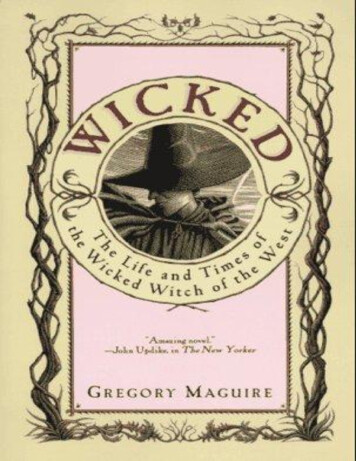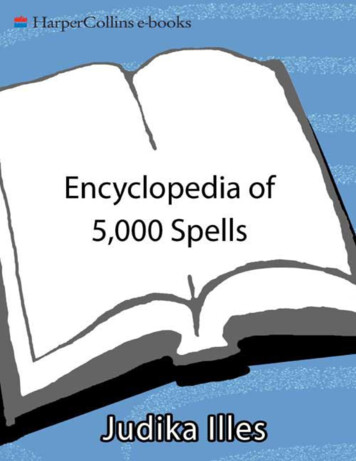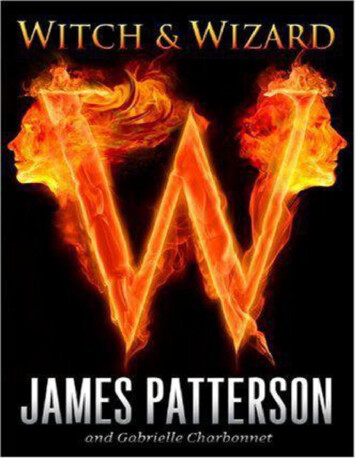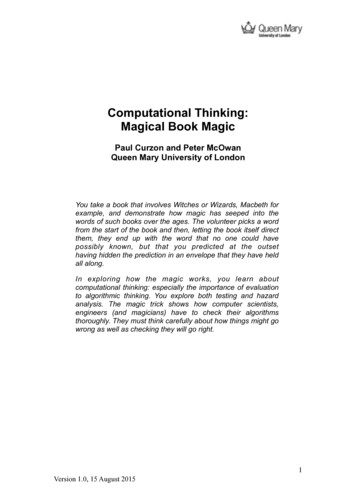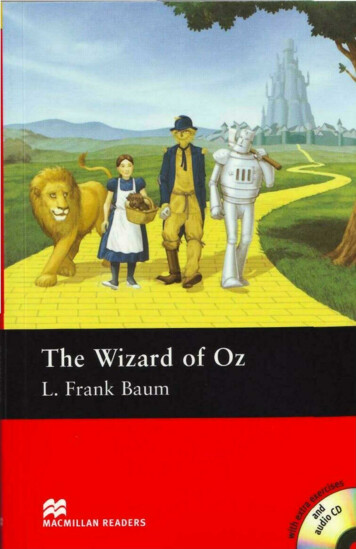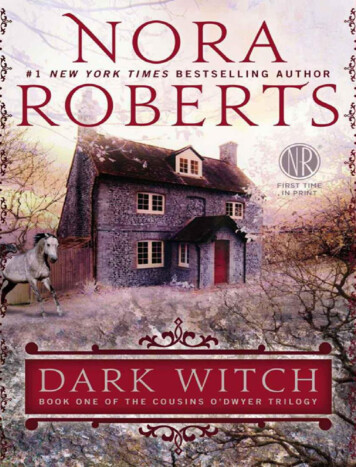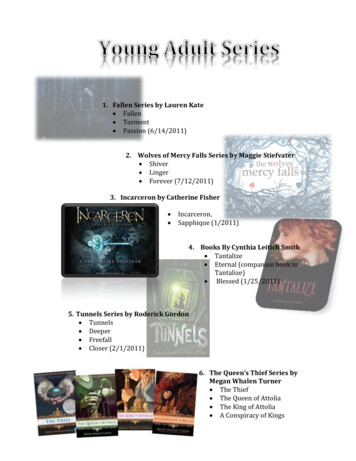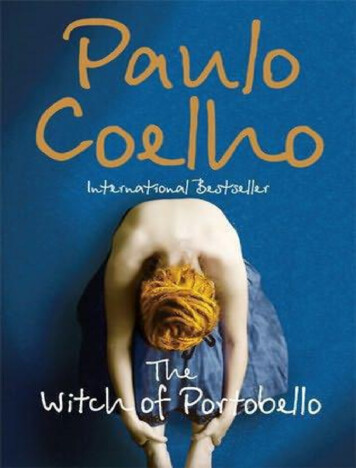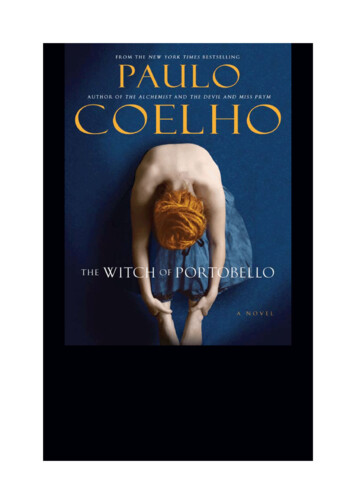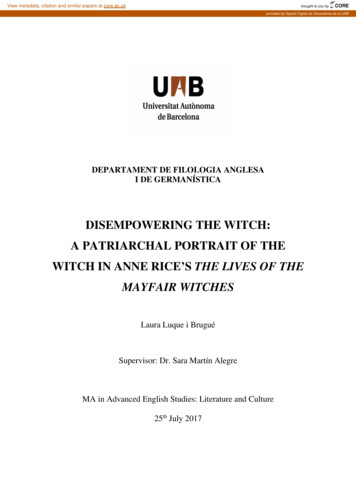
Transcription
View metadata, citation and similar papers at core.ac.ukbrought to you byCOREprovided by Diposit Digital de Documents de la UABDEPARTAMENT DE FILOLOGIA ANGLESAI DE GERMANÍSTICADISEMPOWERING THE WITCH:A PATRIARCHAL PORTRAIT OF THEWITCH IN ANNE RICE’S THE LIVES OF THEMAYFAIR WITCHESLaura Luque i BruguéSupervisor: Dr. Sara Martín AlegreMA in Advanced English Studies: Literature and Culture25th July 2017
Contents0. Introduction: Reclaiming the Witch . 11. From Strong Women to Damsels in Distress: Disempowered Witches in The Lives ofthe Mayfair Witches . 121.1 The Gothic in The Lives of the Mayfair Witches . 131.2. A Disempowered Gothic Heroine: Portraying the Witch in The Lives of the MayfairWitches . 192. Eroticizing abuse: Rowan’s exploitation in The Lives of the Mayfair Witches . 322.1 The Female Gothic: Perpetuating Stereotypes of Women’s Sexuality. 332.2. Rowan’s Exploitation: The Representation of Rape as an Erotic Fantasy . 352.3. The Eroticized Language of Abuse: Erotica and Pornography . 443. Concluding Remarks and Further Research . 51References . 55Appendix . 58
AcknowledgmentsFirst of all, I would like to thank my supervisor, Dr. Sara Martín, for her readinessto supervise my dissertation. She has pushed me to do my best from a genuine belief thatI was capable to achieve what I wanted. Her expertise, patience and support throughoutthe course, and her ability to ask the right questions have been extremely valuable duringthis process. I have learnt a great deal from her, inside and outside the classroom, and shehas broadened my views not only on Literature and gender, but also on the academicworld. It has been delightful and a great pleasure to work with her.I would like to extent my thanks to the other teachers from the Department who,in one way or another, have always offered their knowledge and help when needed. It hasbeen much appreciated.I would also like to thank my mother and my brother, who have patiently enduredmy moments of anxiety, self-doubt and worry and who have always given me the courageto pursue what I am passionate about. I am also deeply thankful to my amazing group offriends: their words of encouragement and their confidence in my abilities have beenessential over the course of the writing process.Last but not least, I must thank Andrea, Gisela, and Laia, without whom the MAexperience would not have been the same. I will always treasure their support andassurance that I was doing significant work, even though sometimes I did not believe itmyself.
0. Introduction: Reclaiming the WitchAnne Rice (1941 -) is an American writer, born in New Orleans. Most of hernovels, including the trilogy here analyzed, in which she mostly employs dark themesand settings, belong to the gothic genre. The novel which launched Rice into literaryfame, Interview with the Vampire (1976), is an innovative retelling of the tale of thevampire from the vampire’s point of view1. Rice’s narrative is often subversive andshocking, as it attacks established social conventions2, much like previous gothic works(Hoppenstand & Browne, 1996: 7). Borrowing Radcliffe’s tradition of the victimizedgothic heroine character, Rice updates this convention with a contemporary twist(Hoppenstand & Browne, 1996) in The Lives of the Mayfair Witches, consisting of thenovels The Witching Hour (1990), Lasher (1993) and Taltos (1994)3.The books that comprise The Lives of the Mayfair Witches were the first gothicstories I read, aged 14. What I read left me with a strong impression, and throughout myteenage years I regarded Rice’s trilogy as groundbreaking. However, after four years ofa university education and an awakening to feminism, I could not but see the trilogy in adifferent light, which is why I offer here a feminist critique of Rice’s novels.I was drawn to and interested in the character of the witch because of this trilogy;specifically the first volume, The Witching Hour, with its long recounting of the lives ofthe witches. I still believe that the history of the lives of the witches from the 17th centuryto the present day of the novels is masterfully written and the fascinating and unusual1Interview with the Vampire (1976) centers on the story of Louis de Pointe du Lac and his struggles toaccept his new life as a vampire. The vampire who turns Louis, Lestat, eventually becomes the protagonistof The Vampire Chronicles, a series of novels which focus on his character. One of the novelties thatInterview with the Vampire presented was the humanization and erotization of the vampire. In 1994, a filmadaptation was released, starring Brad Pitt as Louis and Tom Cruise as Lestat.2Rice’s novels often include topics considered taboo: rape, incest and pedophilia are among the themeswhich the author often deals with.3A fourth book which would follow Taltos, Blood Canticle (2003) is not included within the trilogy becauseit blends in different characters from other novels. In Blood Canticle, Rowan, one of the main characters inThe Lives of the Mayfair Witches, falls in love with Lestat, from the Vampire Chronicles, and Mona alsofalls in love with a vampire from the novel Blackwood Farm (2002) and she becomes a vampire herself.1
lives of the women presented in the trilogy is captivating. These novels have shaped myacademic interest in the history of witchcraft, but also in the representation of the witchin Literature. The attractiveness of the gothic as a literary genre, its themes and theexploration of the human psyche also appealed to me. Therefore, I decided to focus myresearch interests on gothic fiction, focusing on female gothic and its depiction of femalecharacters, specifically that of the witch in Rice’s trilogy.Academically, much has been said about the figure of the witch, yet she continuesto be a major topic for discussion. The configurations and understandings of what a witchis and what the character represents for women are a current debate in cultural andfeminist studies. Besides, her presence in contemporary cultural manifestations increasesthe interest in how she is represented and whether that representation supposes an advanceor a stagnation of the character. It is my belief that The Lives of the Mayfair Witches is acase of the latter. The trilogy cannot be considered feminist Literature in full; the text isproblematic in its depiction of abuse, pedophilia and, to a certain extent, women. Yet, thetrilogy succeeds in raising valid questions about womanhood and rebellious femininity.My main research questions when re-reading the trilogy for this dissertation, therefore,were: why do the powerful female characters at the beginning of the story end updismissed and subjugated to patriarchy? And why is abuse eroticized? In order tounderstand and be able to criticize the text and its representation of the witch, I considerbriefly the witches’ role in Literature, feminism and gender studies. Moreover, I look intothe gothic aspects of Rice’s work and what place she occupies within the so-called femalegothic.The witch, obviously, is not a character that belongs exclusively to the gothic;there are many examples in fiction of all kinds that include her as their main protagonist.The witch has been prominently present in children’s literature (The Witches, 1993, by2
Roald Dahl); in fantastic literature (Good Omens: The Nice and Accurate Prophecies ofAgnes Nutter, Witch, 1990, by Terry Pratchett and Neil Gaiman); and even in theatre (TheCrucible, 1953, by Henry Miller). We can conclude, therefore, that the witches’importance within literature should not be underestimated.As it has been stated before, Rice’s texts belong to the genre of the female gothic,a term coined by Ellen Moers in Literary Women (1976). According to Moers’ definitionfemale gothic “bonded the gender of the author with her subject matter” and “did succeedin placing the question of gender at the heart of any critical analysis of this body offiction.” (in Wright, 2015: 59). Traditionally, the female gothic has been associated withthe combination of a female heroine, an unsettling environment, a villain and the fact thatthe author is a woman. The trilogy of The Lives of the Mayfair Witches features many ofthese gothic characteristics: its protagonists are women in distress, threatened by apowerful, impulsive, tyrannical male; ancient prophecies and supernatural elementscondition the plot. As the trilogy progresses, however, it seems to move towards sciencefiction, a genre that finds its roots in the gothic (Aldiss, 1973), because the plot revolvesaround a new humanoid species, the Taltos, and their shared history with the witches4.Nevertheless, the majority of elements that allow us to identify The Lives of the MayfairWitches as female gothic remain throughout the narrative.Much has been written about Rice’s inspiration source, and critics andbiographers5 generally agree that her life experiences are her principal motivation.Relevant to this dissertation, however, are the comments she has made on feminism andwomen’s freedom in writing as they provide an insight into why certain topics areexplored in her novels. Thus, in 1993, in an interview for Playboy, she stated that: “I4The connection between the Taltos and the Mayfair witches is portrayed in Blood Canticle (2003).Katherine Ramsland analyses Rice’s work, as well as the author’s life, in Prism of the Night: A Biographyof Anne Rice (1991). Ramsland draws connections between key events in Rice’s life to the plots of hernovels.53
believe absolutely in the right of women to fantasize what they want to fantasize, to readwhat they want to read. [ ] I think one of the worst turns feminism took was itspuritanical turn, where it tried to tell women what was politically correct sexually” (Diehl,1993: website). Rice’s opinion is reflected in her writing; The Lives of the MayfairWitches trilogy deals with highly controversial topics —incest, necrophilia, rape— andfeminists of the time criticized her for being sexually and politically incorrect. In regardsto Rice’s comments, the aim of this dissertation is not to censure Rice’s choice of topicbut to criticize the way in which these topics are represented.Second-wave feminism began in the early 1960s and lasted until the late 1980s inthe United States, yet its origins and internal divisions are complex. According to Gamble(2001), two major strands of feminism were initiated in the 1960s. After publishing TheFeminine Mystique (1963), Betty Friedan founded NOW (National Organization forWomen) in 1966. Quoting Gamble: “NOW’s aims lay very much within a liberal EqualRights tradition. It sought to bring women into full participation in the mainstream ofAmerican society now, assuming all the privileges and responsibilities thereof in trulyequal partnership with men” (2001: 25). On the contrary, the Women’s Liberation wasinspired by “the civil rights, anti-Vietnam War and student movements of the 1960s” but“Unlike NOW, these groups had no national organization; instead they drew on theinfrastructure of the radical community, the underground press, and the free universities”(2001: 26).Appropriate to this dissertation is the movement that sprung from the Women’sLiberation strand. In 1969, the radical feminist movement, W.I.T.C.H (Women’sInternational Terrorist Conspiracy from Hell) was founded in New York by RobinMorgan and Florika. W.I.T.C.H was an action-based group, and its main targets werecorporate America and patriarchy, not all men. Nevertheless, tensions rose between the4
New York Radical Women (N.Y.R.W.) and W.I.T.C.H, which used to be part ofN.Y.R.W. After a while, however, W.I.T.C.H abandoned action and it only became aconsciousness-raising group (Echols, 1989).The choice of the witch as a symbol by the W.I.T.C.H members is best explainedby Cynthia Eller: “by choosing this symbol, feminists were identifying themselves witheverything women were taught not to be: ugly, aggressive, independent, and malicious.Feminists took this symbol and molded it - not into the fairy tale ‘good witch’, but into asymbol of female power, knowledge, independence, and martyrdom” (1993: 55).Therefore, the witch became a hallmark of the woman who stands up to patriarchy anddefies it by being everything patriarchy does not want her to be: assertive, strong andindependent.Choosing the witch as a feminist emblem was not a random act; the witch hadbeen associated with evil, sin and immorality for many centuries and she was employedin accusations of blasphemy to control women. The Malleus Malleficarum (Krammer,1487; Sprenger, 1519), the most influential treaty on witchcraft and witch extermination,vilified witches and made their status akin to that of criminals. By reversing thepatriarchal conception of the witch, feminists were reclaiming a despised character andturning her into a woman they could identify with, and be proud of. Later on, manyfeminist scholars, Luce Irigaray (Speculum of the Other Woman, 1974); Hélène Cixous(The Laugh of the Medusa, 1975); Mary Daly (Gyn/Ecology: The Metaethics of RadicalFeminism, 1978 and Websters’ First New Intergalactic Wickedary of the EnglishLanguage Conjured in Cahoots with Jane Caputi, 1987) and Barbara Creed (TheMonstrous Feminine, 1993), among others, analyzed the figure of the witch withinculture, feminism, history and literature. Most relevant to this dissertation are the works5
by Diane Purkiss (1996) and Justyna Sempruch (2008), two of the most recent scholarswho have focused their research on the representation of the witch within Literature.The witch, then, has been a prominent research topic within Literature studies,especially during the 20th and 21st century, and particularly popular among feministscholars. Purkiss’ research in The Witch in History: Modern and Twentieth-centuryRepresentations (1996) covers different periods, although not exhaustively. Her researchbegins with representations and reinterpretations of the witch by radical feminists andmodern ‘real’ witches.6 Nonetheless, her focus falls on the early modern stage, focusingon works such as The Tempest, by William Shakespeare (1610-11) and The Witches ofLancashire, by Thomas Heywood and Richard Brome (1634).Purkiss analyzes how historians and feminists have reinterpreted the witch andone of her main arguments is that the character of the witch has been manipulated notonly by patriarchy but also by feminists. The first witch within the Mayfair family,Suzanne, is the perfect example of a character that feminist scholars would use toreinterpret the figure of the witch. Suzanne was an esteemed village healer in Donnelaith,Scotland, and when a witch judge went to her for a cut he had on his hand, he told her tobe careful with dark magic, and showed her the Daemonologie (1597)7. Suzanne, whowas believed to be a little imprudent, called forth Lasher without really knowing what shewas doing. Therefore, Suzanne never learnt how to control Lasher, and thus her powerwas known, which led her to be burnt at the stake. Suzanne’s story perfectly fits withinWhen Purkiss talks about “real witches” she refers to the neopagan religion, Wicca. Wicca was developedin England during the 20th century and introduced by Gerald Gardner in 1954. Wicca encompasses theists,atheists, and agnostics and it is typically duo theistic, worshipping a Goddess and a God, and it does nothave a central authority. Because of its decentralized nature, there is some disagreement as to whatconstitutes Wicca. There are different denominations and traditions of Wicca and its sacred scripture is TheBook of Shadows, written by Gardner between the 1940s and 1950s.7The Daemonologie was a book written by King James VI of Scotland. The book affirmed the King’s fullbelief in magic and witchcraft, and intended to prove the existence of such forces and dictate what sort ofpunishment these practices deserved.66
the traditional view of what witches were: midwives and healers persecuted bymisogynistic, patriarchal men. Feminist scholars would use Suzanne’s burning story fortheir own agenda; quoting Purkiss:The witch offers opportunities for both identification and elaborate fantasy, standingin a supportive or antagonistic relation to the contemporary feminist-activisthistorian inscribing her. To remark this is not to side with those notorious critics ofwomen’s history who see feminist historians as unreasonably ‘biased’; feministhistories are no more ‘biased’ than those male historians who have taken up thefigure of the witch and reformulated it according to their needs and fantasies.(Purkiss, 1998: 10)In other words, witches are attributed special features and singular stories to help thefeminist cause. Purkiss refers to this phenomenon as the myth of the “Burning Times”:The myth of the Burning Times was invented at the point when the women’smovement began to turn away from rights-centered public-sphere issues towardscrime-centered, private-sphere issues. Domestic and sexual violence against womenwere foregrounded as the representative crimes of patriarchy, to the exclusion ofother issues. Sexuality was to be identified as the site of women’s oppression in thesense that property was for Marx the site of class oppression. Rape, sexual violence,pornography, wife-battering and (eventually) child sexual abuse became the centralsignifiers of patriarchy, replacing signifiers such as legal asymmetries and paydifferentials. These trends were influential inside as well as outside the academy.(Purkiss, 1998: 15)So, the myth that women were burnt because of their daring sexuality was used by secondwave feminists to reclaim the witch as a powerful symbol. Purkiss also warns us from thebeginning that: “the witch is not solely or simply the creation of patriarchy, but womenalso invested heavily in the figure as a fantasy which allowed them to express and manageotherwise unspeakable fears and desires, cent[e]ring on the question of motherhood andchildren” (1996: 3).In her conclusion, Purkiss reminds us that the witch is most present, even in modernLiterature, in children’s fiction and folktales:The witch’s consignment to the world of childhood infects historical accounts of her.She is the bogey of Western society’s infancy, a feature of our early years as aculture. She exemplifies the dark ages, the primitive, the superstitious, theunenlightened. (1996: 278)7
Sempruch’s study Fantasies of Gender: The Witch in Feminism and Literature(2008) revises the configuration and understanding of the figure of the witch in differentNorth American and European texts from a feminist perspective. Sempruch’s aim, then,is to “develop a new concept of the witch, one that challenges stigmatized forms ofsexuality, race and ethnicity as linked to the margins of culture and monstrous femininedesire” (Sempruch, 2008: 1). In order to do so, Sempruch pinpoints three theoreticalpositions for what the witch represents according to different scholars who have dealtwith the character (real or fictional):1) [the witch] as a radical feminist (political) figure representing the culturallysubjugated and victimized woman (Daly, Dworkin), and her subsequent herstoricalreconfiguration into a sovereign, mythic and powerful ‘‘superwoman’’ (Cixous,Wittig, Gearhart, Walker); 2) [the witch] as a problematic dialogical figurecollapsing into the archaic forms of the pre-symbolic mother and the phallicmonstrous feminine (Kristeva, Creed); and 3) [the witch] as a borderlinephenomenon suspending logocentric discourse and opening thus heterogeneousspaces beyond the accumulation of stigmas, but also beyond the mythic origin,maternal jouissance or femininity (Irigaray, Butler, Braidotti). (Sempruch, 2008:5)Sempruch examines the witch archetypes and contrasts them with fictional texts fromdifferent political and cultural contexts. The first and second theoretical approaches thatSempruch establishes are especially useful to my dissertation, since two of the trilogy’scharacters, Mary Beth and Rowan, might be analyzed according to these categories. MaryBeth is a transgressive figure; she fulfils the ideal of a liberated woman who challengesestablished norms of conduct, whereas Rowan remains static and even degenerates thenotion of the witch as a disobeying figure.In the same Playboy interview that has been previously mentioned, Rice defendedherself and her artistic freedom from the feminists who criticized her pornographic work,The Sleeping Beauty Quartet8: “to hear the feminists then telling me that having8The Sleeping Beauty Quartet is formed by The Claiming of Sleeping Beauty (1983), Beauty's Punishment(1984), Beauty's Release (1985) and Beauty's Kingdom (2015). Rice published the novels under thepseudonym of A. N. Roquelaure. The novels are labelled as BDSM pornography, and the plot is set in a8
masochistic fantasies or rape fantasies just isn’t politically correct, I just thought, Oh,bullshit. You’re not going to come in and politicize my imagination” (Diehl, 1993:website). Remarkably, rape is one of the major issues in The Mayfair Witches. Rice’swork contains a depiction of a strong matrilineal line of witches who have defendedthemselves against patriarchy and who have defied gender normative constructions. Yet,the main protagonist in The Witching Hour (1990) and Lasher (1993), Rowan, isrepeatedly abused, raped, and deprived from all the strength she presents in the beginningof the series. The power given to Rowan through her status as a witch is undermined anddismissed: not even her supernatural capacities prevent her from being harmed.When asked specifically about rape, Rice offered two contrasting positions: “Ithink it’s important to women’s freedom and important to our dignity and our rights ashuman beings, that rape be a crime, that nobody has a right to force himself on you,whatever you are. [ ]” (Diehl, 1993: website). In her answer, Rice is clearly condemningrape. Nevertheless, when asked about the representation of rape in culture, she answered:“I praise that movie [Thelma & Louise] because I think it showed how awful rape is. Andit’s hard to show it without its being sexy because it [rape] is sexy.” (Diehl, 1993: website;my italics). Authors are entitled to their personal opinions and beliefs, and these might beof interest to the readers. Nonetheless, texts which present such controversial topics oughtto be analyzed and criticized accordingly, especially when rape is a major theme withinliterature and gender studies. Susan Brown’s Against Our Will (1975), Gloria Steinem’s“Erotica and Pornography: A Clear and Present Difference” (1980), Andrea Dworkin’sPornography: Men Possessing Women (1981), and Susan Faludi’s Backlash: TheUndeclared War Against American Women (1991) are among the works that particularlymedieval fantasy world in which Beauty is awakened through copulation by the Prince. Afterwards, Beautyis trained as a sex slave and the novels describe the sexual adventures of Beauty and the male charactersAlexi, Tristan and Laurent.9
tackle this issue. Rowan’s psyche, power and position within the series shift so drasticallyduring and after the act of rape that its representation and its consequences within the textare worth analyzing. By using the text as support, and the author’s assumptions aboutrape and rape fantasies, I shall argue that an incorrect, eroticized representation of thisissue is harmful not only to readers, particularly the younger ones, but to the text itself.Certainly, witches are often regarded as attractive characters, and even consideredfeminist role models within Literature. Nevertheless, according to Ringel, “the witchbelief was not central to the first Gothic revival, nor are witches common protagonists inmodern horror” (Ringel, 1998: 260). Nonetheless, the situation has completely changed.The figure of the witch has gained presence in gothic fiction and horror and she hasbecome a commonly used character.The witches in Rice’s trilogy lose their status as powerful women as the storyunfolds, to finally be subjugated to the most horrifying aspects of patriarchy, embodiedby Lasher. It is my aim, then, to analyze the change of status quo within The MayfairWitches as well as the implications that the eroticization of abuse supposes in therepresentation of women within female gothic.This dissertation will be organized into two main chapters, each focused in one ofthe major issues within the trilogy. The first chapter will deal with the witches’ declinefrom progressive and antipatriarchal characters to conventional and passive ones, as wellas its consequences for female representation, femininity and the female gothic. Thesecond chapter will focus on the text’s eroticized language when describing abuse andrape, as well as the problematics of considering and labelling such controversial issues aserotic literature. Since the trilogy is extensive and difficult to summarize, a plot summarywill be included in the appendix.10
11
1. From Strong Women to Damsels in Distress: Disempowered Witchesin The Lives of the Mayfair WitchesAs I have already explained in the Introduction, Rice’s The Lives of the MayfairWitches (1990-1994) is a gothic romance trilogy recounting the story of a New Orleansfamily of witches since the 17th century. The Mayfair witches are haunted by an incubusspirit, the Taltos Lasher, whose main goal is to become flesh again. The plot focuses onRowan Mayfair, the thirteenth witch of the family line, and her struggle to prevent Lasherfrom entering the human world, and the terrible consequences once she fails to do so.My purpose in this first chapter is to highlight the ways by which The Lives of theMayfair Witches seemingly transgresses gender normative roles regarding women withinthe female gothic genre. The Lives of the Mayfair Witches might seem a progressive workin terms of female desire, femininity and women’s representation within female gothic,yet, the text fails to produce a convincing feminist heroine who challenges establishedrules. Although Rice alters some premises of the female gothic genre, the text perpetuatesstereotypes regarding femaleness, mainly those concerning conventional femininity andmaternity.In order to explain the witches’ disempowerment in Rice’s trilogy, I will firstanalyze the gothic elements of the text. Different gothic aspects of the trilogy will helpunderstand the limitations of representing women within this genre, and shall provideclarifications as to why it seems impossible to move beyond set stereotypes.Subsequently, the witches within the story will be examined: the development of theleading female protagonist, Rowan, is not towards a progressive representation of womenor witches. In fact, it is a regression of the character and of the text itself. Whilerepresentations of the witch in culture have moved towards a more feminist portrayalduring the 20th and 21st centuries—with characters such as Willow, from Buffy; Queenie,12
from American Horror Story; Hermione, from The Harry Potter Series, by J.K Rowling,and Bonnie McCullough, from The Vampire Diaries Series by L.J Smith— Rice’s mainwitch is not only static, she deteriorates even in comparison to other witches within thesame trilogy. Hence, the transgressive portrait of the Mayfair witches is ambiguous: theopen-minded picture of the Mayfair witches within the Talamasca File9 fades when theaction is focused on the contemporary women of the story. Consequently, the witch as afeminist figure will also be analyzed in order to answer the following question: is thewitch a powerful female character as represented in Literature or does she still carrymisogynist connotations and, therefore, cannot fulfill her role as a feminist icon?1.1 The Gothic in The Lives of the Mayfair WitchesRice’s popular fiction undoubtedly belongs to the gothic/horror genre. Hoppenstandand Browne (1996) analyze Rice’s gothic leanings, arguing that “Her most popularnovels, such as Interview with the Vampire (1976) and The Witching Hour (1990), thoughsituated within the gothic narrative tradition, go far beyond the conventions of the formulaand explore important contemporary social issues” (Hoppenstand and Browne, 1996: 2).Rice’s gothic influence is also considered in their article, tracing it back to HoraceWalpole’s The Castle of Otranto (1764), Ann Radcliffe’s The Mysteries of Udolpho(1794) and Matthew Gregory Lewis’ The Monk: A Romance (1796):The traditional gothic narrative has always been a subversive literature, shocking itsaudience by attacking established social conventions, and Rice continues this9The Talamasca File is a body of files, letters and documents within The Witching Hour which recountsin detail the history of the Mayfair witches from the beginning. The File is kept and updated by theTalamasca, a secret society which investigates the supernatural. To exemplify, in the Talamasca File thereader finds out that Charlotte Mayfair (1667- 1743) founded and ruled the Maye Faire plantation inLouisiana, something unusual at the time. It is made clear that she was not the plantation mistress, but theplantation owner. She gave birth to Jeanne-Louise Mayfair (1690 - 1771) through copulating with herfather, Petyr Van Able. Jeanne-Louise was the first woman of the fa
gothic heroine character, Rice updates this convention with a contemporary twist (Hoppenstand & Browne, 1996) in The Lives of the Mayfair Witches, consisting of the novels 3The Witching Hour (1990), Lasher (1993) and Taltos (1994) . The books that comprise The Lives of the Mayfa


